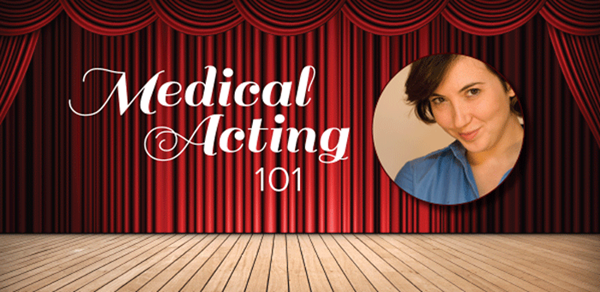Medical simulation has experienced rapid growth over the past 15 years, with up to 92% of emergency medicine residencies using simulation in some capacity.1 It provides a great way to learn fundamentals of medicine, try new procedures, develop skills, and work on communication.2 But all of these cases rely upon confederates: case actors pretending to be nurses, family, consultants, or paramedics who know what is expected to happen but must also improvise alongside the participants taking care of the patient.
While confederates are sometimes professional actors, many of these performances involve physicians or medical students playing the role of RN, consultant MD, or family member. It requires a unique set of skills that is rarely taught or discussed in medical school or residency training.
To learn more about how to deliver convincing performances in simulation scenarios, the authors of this article sat down with a local professional actor (MB), who works both as a standardized patient and as a confederate at the Coro Simulation Center at Rhode Island Hospital. Without further ado, here are her tips for becoming the next top medical simulation performer.
MB's List to SHINE as a Performer (A-list Rec's)
- Stay in character — In order for the learners to be fully engaged with the case and with your role, you have to believe in your own character first to make it as convincing as possible.
- Gather from real-life experiences — You do not need to have suffered from a heart attack or be fully intoxicated to know how they present in real life. Dig deep into your memory banks with those patient encounters to create a believable performance throughout the simulation.
- Use your imagination — It is often helpful to imagine yourself as the actual patient experiencing the first “worst headache of his life” or surgical abdomen. The mind is a powerful organ, and it can bring out our inner star.
- Take a mini-mental break — As an actor, you do not have to fill every silent moment. Learners sometimes learn the most during these moments when they can process the clinical situation. So, take a break, readjust, and carefully nudge your learners back to the learning objectives.
- Practice makes perfect actors — We may not all be Meryl Streep or Leonardo DiCaprio, but with practice and real-time feedback, we can perfect our roles, hone our skills, and bring life to the simulation cases.
MB's List to SINK as a Performer (a.k.a. Avoid at all costs!)
- “Too cool” to act — Part of being a case confederate is creating a believable persona that complements the case scenario. By purposefully nulling your emotions, you risk disrupting the fabric of illusion and believability of the case.
- Stealing the spotlight — Avoid over-acting as much as under-acting; either gesture outside the script can derail the focus away from the learning objectives.
- “Line?” — Just because your confederate role involves a patient with altered mental status, it does not mean you should forget your cues or case-specific reactions. Read and practice the scripts, and consider going over complicated case details with the writers if you have any questions.
- Ignoring the learning objectives — Your main job as the confederate actor is to allow the case writers to relay their learning objectives to the learners. Getting an Oscar nomination as your institutional Best Sim Actor should be your secondary prize.
- Giggling — This may sound silly, but giggling during your speech can spell instant disaster by shattering the veil of the simulated environment, thereby diminishing your credibility as a believable character.
Actor's Bio: Melissa Bowler is the executive director of the Providence Improv Guild and has been performing professionally since 2005. She is a simulation specialist at Women and Infants Hospital and a Standardized Patient at Alpert Warren Medical School at Brown University. She lives in Providence, Rhode Island, with her 3-year-old son, Luc.
References
- Okuda Y, Bond W, Bonfante G, et al. National growth in simulation training within emergency medicine residency programs, 2003-2008. Acad Emerg Med. 2008;15(11): 1113–1116.
- Okuda Y, Bryson EO, DeMaria S, et al. (2009). The Utility of Simulation in Medical Education: What is the Evidence. The Mount Sinai Journal of Medicine. 2009;76(2):330–343.



